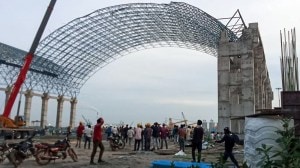Many worlds, one universe
At a time when some in the West talk of a green menace and others are prepared to go along with Samuel Huntington's vision of the future i...

At a time when some in the West talk of a green menace and others are prepared to go along with Samuel Huntington’s vision of the future in terms of the clash of civilization, participants from Iran and India happily discovered a convergence of interests, last week, at a significant initiative to promote dialogue among civilizations during a conference held at the picturesque Rajput fort in Nimrana. They talked about the harsh realities of living in a unipolar world and a globalised economic order, but they also felt that there existed considerable space for an open-ended cultural dialogue, based on a nuanced understanding of our respective societies.
How, then, to sustain an Indo-Iranian dialogue? Surely, it is not good enough to invoke the poetry of Amir Khusro or the magisterial historical works of Abul Fazl. For us in India, the task ahead is to acquaint people living in Iran with the strength and vitality of our democratic and secular experiment. A democratic empowerment of the lower castes, the chief catalyst for what has been described as the second democratic upsurge, has made India’s democracy more inclusive and participatory. Indeed, the Indian political regime is one of the most democratic in the world, by most conventional measures of political participation, electoral and party competition, and persistence of parliamentary institutions.
Equally, the people of Iran counterparts should know a great more about the loose and widely divergent tendencies amongst India’s 110 million Muslims. As in that country, where Islam incorporated a variety of outlooks and orientations and has been capable of multiple levels of discourse and interpretations, in its local and regional specificity, the “essential” core of Islam in India has not been immune to changes by historical influences. Ordinary Muslims are not, as one is often led to believe, members of a monolithic community sitting sullenly apart, but were active participants in regional cultures whose perspectives they shared.
Those holding the reins of leadership locate problems and find answers to contemporary dilemmas within the democratic and secular paradigms. They accept state laws without insisting on the application of the Islamic law, except in the case of marriage, divorce and inheritance. In sum, beneath the so-called unity of the Muslim community, it is necessary to uncover a variety of religious and political outlooks and competing agendas. This may well unravel the “mysteriously known essence” (Edward Said) of Islam in India and Iran, and challenge the worldwide perception of a monolithic “Islamic threat”.
This is not all. Whether it is for the purpose of exploring our heritage or for the noble cause of forging closer cultural ties, we need to incorporate rather than discard the colonial factor in our discourses and be mutually sensitive to Western misrepresentation, stereotyping, and the colonial construction of a hostile politico-ideological structure, a different civilization, and an alien economic region. These representations have, after all, lent depth and legitimacy, even after decades of Independence, to primordial loyalties and identities in India and Iran. To resolve these problems, some of which are threatening to tear apart the fabric of our neighbours, we need to question the colonial assumptions about our societies and develop our own theories of state and society
Sadly, the Indian academia has neglected the study of our neighbours. For the recent initiative to get off the ground, we need to contextualise Iran’s history and contemporary politics and not be influenced by the images, myths, and the categories invented by some Western scholars. Contrary to popular perceptions, Iran is not the bastion of Islamic fundamentalism threatening to overrun its neighbours, but a society trying to come to terms with its past and its contemporary dilemmas. We must respect Iran’s search for its own identity.
After all, religion and the state have been intertwined ever since the establishment of the Safavid dynasty, and that it is impossible to delegitimise the role of Islam or the ulema in popular mobilisation. Notice, for example, that on two more recent occasions — the Tobacco Protest (1891-92) and the Constitutional Revolution (1905-11) — Islam and the Muslim divines played an important oppositional role in the emergence of modern Iranian nationalism. Today, Islam continues to be a source of government legitimacy in Iran. Successive governments will continue to appeal to Islam to enhance their authority, buttress nationalism, legitimate policies and programmes, and increase popular support.
My second proposition centres on the role of Shia emotionalism, which took on special significance and provided the inspirational model for the revolution. Indeed, evocative Shia symbols contribute to the making and crystalisation of Iranian self-consciousness and lend a distinct character to Iranian nationalism. Historically, Shia Islam exercises a far-reaching influence on Shia political culture than Sufi tendencies have in Sunni societies. Among other aspects, it has influenced the nature and character of Iranian nationalism. The symbolic component of politics in Iran, especially after the inglorious regime of the Shah, is especially significant because it could have been used as an instrument of persuasion as well as coercion. Yet bargaining models of politics suggest that persuasion rather than force, is increasingly considered to be the basis of politics in Teheran.
My final point is that politics in Iran is sufficiently complex. As a result, attempts to reduce it to a single formula leads to mystification; rather than being monolithic, Muslim politics, while aspiring to umma-wide universals, derives its force and significance from the specific contexts, times, and localities in which it takes place. “Islam” cannot thus be a threat, any more than the “West” can be for Muslims. Muslim politics have a transnational dimension, as is illustrated by the responses to Israel’s illegal occupation of Palestine, but this does not imply that one Muslim cultural unit has coalesced or that a transnational Islamic space has acquired dominance.
Foreign policy makers in India and proponents of a civilisational dialogue have to come to terms with an Iranian personality and an Iranian ethos that is different from Arab/Turkish nationalism. They need to recognise this reality in order to negotiate with Tehran on a familiar terrain.
Muslim politics have a transnational dimension but this doesn’t imply that one Muslim cultural unit has coalesced or that a transnational Islamic space has dominance



- 01
- 02
- 03
- 04
- 05




























